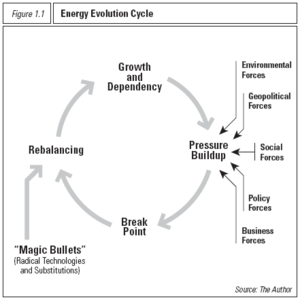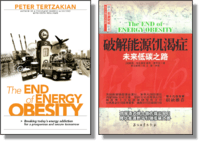Peter Tertzakian
| Peter Tertzakian | |
|---|---|
|
Peter Tertzakian at the Halifax International Security Forum 2014 | |
| Born | Saskatoon, Saskatchewan, Canada |
| Residence | Calgary, Alberta |
| Occupation | economist, investor, author, public speaker |
| Spouse(s) | Janet |
| Children | Alexander, André |
| Website | www.endofenergyobesity.com |
Peter Tertzakian is an economist, investment strategist, author and public speaker. He is Chief Energy Economist & Managing Director at ARC Financial Corporation, an energy-focused private equity firm. With over 25 years in the energy industry and finance industry, Tertzakian is responsible for strategic investment research. His two books, A Thousand Barrels a Second and The End of Energy Obesity, both examine the transformation of the global energy sector through economic, environmental and geopolitical pressures. In addition to English, translated versions of his books have been published in Chinese, Japanese and Arabic. Passionate about the history and direction of energy in society, Tertzakian delivers speeches and presentations at events around the world.[1] Over the years he has given advice to corporate leaders, policy makers and students, which have earned him many accolades for his work. His background in geophysics, economics, and finance has established him as an internationally recognized expert in energy matters.
Personal
Raised in Edmonton, Alberta, Peter Tertzakian is now a long-time resident of Calgary, Alberta. He lives there with his wife, Janet, and together they have two children, Alexander and André. Peter enjoys photography, and uses photos from his world travels to enrich his presentations. As a collector of Energy related artifacts, books and ephemera he often uses them as a source of inspiration to share historical lessons that can be applied today.
Education and Qualifications
Peter Tertzakian has an undergraduate degree in Geophysics from the University of Alberta, and a graduate degree in Econometrics from the University of Southampton, U.K. He also holds a Master of Science in Management of Technology from the MIT Sloan School of Management. Tertzakian is an Adjunct Professor with the Haskayne School of Business at the University of Calgary where he contributes to thought leadership in pressing energy issues. Tertzakian sat on the MIT Natural Gas Advisory Committee with the MIT Energy Initiative that focused on energy demand, infrastructure, geopolitics, research and development.
Career
Peter Tertzakian began his career as a geophysicist with the Chevron Corporation in 1982 where he spent eight years working in field operations, seismic data processing and geophysical software development. He moved from the oil & gas to the financial sector in 1990 and has since been analyzing technology and energy-related businesses.
Tertzakian became a well-recognized, top-ranked equity analyst amongst a global institutional client base. He was prominently ranked by the Brendan Wood International survey of financial institutions. In particular, he was ranked within Canada: • No. 1 Special Situations Analyst, Brendan Woods Survey, May 2001 • No. 1 Oil & Gas Services Analyst, Brendan Woods Survey, 2000 • No. 1 Oil & Gas Services Analyst, Greenwich Survey, 2000 • No. 2 Oil & Gas Services Analyst, Brendan Woods Survey, 1999.
Tertzakian joined ARC Financial Corporation in 2002 after 20 years in the energy and finance industry. He is a member of the Executive, Investment and Strategy committees. In addition to directing ARC Financial's economic research, he oversees the publication of the ARC Energy Charts, a weekly journal of energy trends. Tertzakian currently represents ARC on the board of Nexterra Systems Corporation. He is also a Board Chairman of the Honens International Piano Competition.
Moving the Energy Debate Forward
Constantly analyzing energy trends, Peter Tertzakian is often quoted and seen in the media. In print, Tertzakian has been featured in US News and World Report and has contributed editorials to widely read publications like The Globe and Mail and Forbes. He is a regular columnist with such publications as the Calgary Herald[2] and the Journal of Canadian Petroleum Technology (the official publication of the Canadian Institute of Mining, Metallurgy and Petroleum). He has been a featured guest on many high-profile radio and television shows, including an appearance on The Daily Show with Jon Stewart.
Tertzakian’s presentations examine critical energy issues of our time.[3][4][5] Tertzakian presents a complete view on our energy situation. He addresses how mankind can bring its energy consumption under control, as the global energy appetite grows from industrialization, mobilization and wealth creation. He explores how innovation and crisis will drive change in the energy supply, and how policy and technology will drive change in the energy demand.
His advice to corporate leaders and government officials is helping to direct policy in the energy sector. Tertzakian has appeared on a number of panels and advisory boards established by government in Canada and around the world.[6] At ARC Financial Corporation, Tertzakian and his team have produced a series of reports for the Canadian Association of Petroleum Producers (CAPP) on capital spending in the industry and the fiscal policy issues facing Canadian energy producers.
The asteroid 100077 Tertzakian has been named in his honour.†
Opinion and Stances
Energy Break Points

Tertzakian coined the term "energy break point" to describe historical junctures when unsustainable pressures on a dominant energy regime (i.e. wood, coal) lead to its replacement. The mechanics of the entire break point process is described in detail in A Thousand Barrels a Second and is illustrated in Figure 1.1. Energy consumption behavior is regulated by an energy evolution cycle. As revealed by the First Principle of Energy Consumption every economy uses more energy as it grows. Whether wood, coal or crude oil, primary resources are exploited as the economy expands, energy consumption increases and dependencies form. As a new energy source or carrier takes root in a society, a frenzy of new products and services proliferate to take advantage of the opportunities. Eventually, the primary energy resource becomes scarce, and pressure from a variety of forces — including environmental concerns, geopolitical competition, social trends, policy decisions, and business behaviors — begins to build. Although these forces eventually rebalance within a new regime, Tertzakian feels that with global oil consumption exceeding one thousand barrels per second, a dramatic break point with far-reaching consequences is at hand. In comparison to the manageable break point period experienced during the oil shocks of the 1970s, today's predicament has the potential to be longer, more confusing and unmanageable because there are no radical technologies or simple fuel substitutions available.
Energy Obesity
In The End of Energy Obesity, Tertzakian employs the metaphor of "energy obesity" to characterize the soaring of global energy consumption or “appetite”. Like cheap junk food, long-term availability of cheap energy has allowed industrialized countries, especially the United States and Canada, to become accustomed to a lifestyle of overconsumption: fuel efficient cars have been traded in for gas-guzzling SUVs; houses have been built increasingly larger and farther away from where people work; and lifestyles depend on central heat and air conditioning, year-round access to fresh fruits and vegetables, and cheap foreign-made consumer items. Any energy saved with technological advances in efficiency, is promptly consumed.
The Asymmetry Principle
As a conceptual tool to assess the gains available through raising efficiency, Tertzakian introduces the Asymmetry Principle which he defines as "the lopsided relationship between how much raw energy is available at the primary source — for example, at an oil well — and the small fraction of energy that is actually put to useful work at the consuming end. The Asymmetry Principle states that a unit of energy saved at the consumer level amplifies into multiple units of energy saved at the source. In effect, the Asymmetry Principle exposes the high levels of inefficiency in society’s energy systems and highlights the tremendous leverage offered by efficiency gains and conservation in mitigating source energy consumption."
Natural Gas
Tertzakian argues that natural gas is well-suited as twenty-first-century fuel as economies transition to a "low carb" energy diet. Natural gas as a fossil fuel produces almost 25% less carbon dioxide per unit of energy input than oil and almost 50% less than coal. Innovation in the area of hydraulic fracturing (“fracking”) has opened huge reserve potential in the area of unconventional gas with reservoirs of various geologic types including shales, tight gas and coal beds. Geologists have not arrived at any definitive numbers based on the new capabilities, but Tertzakian considers that the United States alone has 1,000 trillion cubic feet (Tcf) of exploitable natural gas, the equivalent of 166 billion barrels of oil. Tertzakian cautions against too much faith in the role renewable energy forms such as wind, solar and biofuels can play in the short- and mid-term owing to limitations on their scaling up to take market share away from the entrenched incumbents such as oil and coal. As the cleanest of the hydrocarbons, natural gas appears set to play a role of ever-increasing importance in the world's energy supply mix.
Dissolving Distance
Despite the hope being placed in renewable energy forms, clean-tech devices, offshore drilling, efficiency gains and carbon taxes, the vast new demands being placed on the world's resources by the ever wealthier 5.8 billion people of the developing world — in particular, China and India — means global demand for affordable, clean, and secure energy can't be achieved by following old paradigm approaches. Tertzakian alters the perspective by assessing energy consumption as a function of our socio-economic template and infrastructure. This leads to refreshing new insights that reveal how some of the most promising solutions will come unexpectedly from outside of the energy sector itself. In The End of Energy Obesity, Tertzakian shows how information and communication technologies are developing at a rate that far exceeds energy efficiency improvements in combustion engine based propulsion. In fact, certain ICT innovations such as Cisco's telepresence and Skype telephony dissolve our sense of geographic distance through virtualization processes and hold great promise in making many forms of petroleum-dependent transportation redundant.
Published works
- A Thousand Barrels a Second: The Coming Oil Break Point and the Challenges Facing an Energy Dependent World (2006). ISBN 0-07-149260-7; ISBN 978-0-07-149260-7.
- The End of Energy Obesity: Breaking Today's Energy Addiction for a Prosperous and Secure Tomorrow (2009). ISBN 0-470-43544-5; ISBN 978-0-470-43544-1.

External links
- Follow Peter on Twitter @PTertzakian
- Visit his LinkedIn http://ca.linkedin.com/pub/peter-tertzakian/92/28b/45b/
- October 2014 interview with the Oil Council http://www.oilcouncil.com/videos/peter-tertzakian-arc-financial-says-he-will-not-be-suprised-see-oil-price-go-lower
- Peter Tertzakian's official website
- A Thousand Barrels a Second official website
- Campbell, Colin (June 2009). "Energy Shock and Oil Myths". Macleans.ca. Retrieved 2009-06-16.
References
- ↑ http://www.arcfinancial.com/index.php?id=94&option=com_content&task=view
- ↑ http://www.calgaryherald.com/columnists/Peter_Tertzakian.html
- ↑ http://www.nationalbuyersellerforum.ca/documents/NBSF2010_PeterTertzakianPromo_v2.pdf
- ↑ http://www.cisco.com/web/strategy/docs/energy/Calgary_delegates_kit_inside.pdf
- ↑ http://nsb.com/speakers/view/peter-tertzakian
- ↑ http://www.albertaroyaltyreview.ca/public_meetings/transcripts_submissions.html